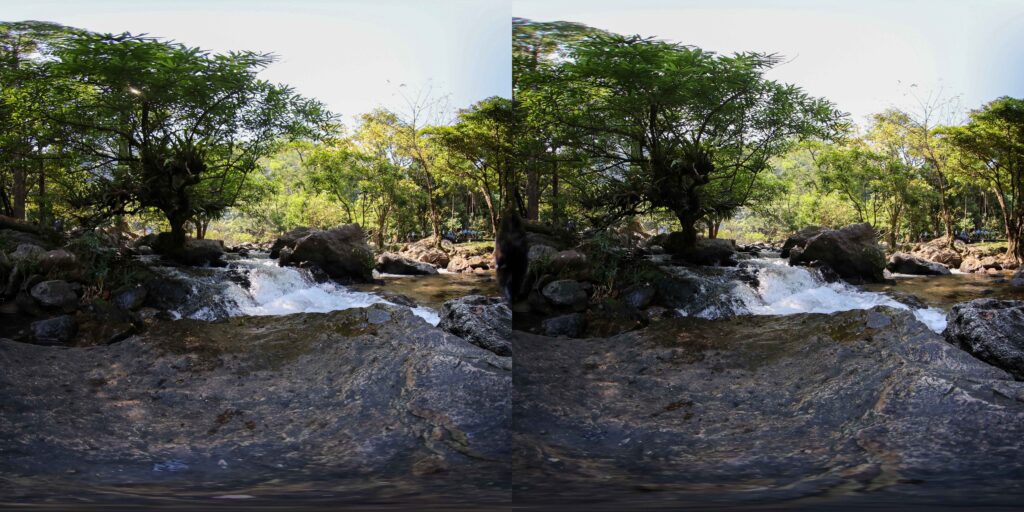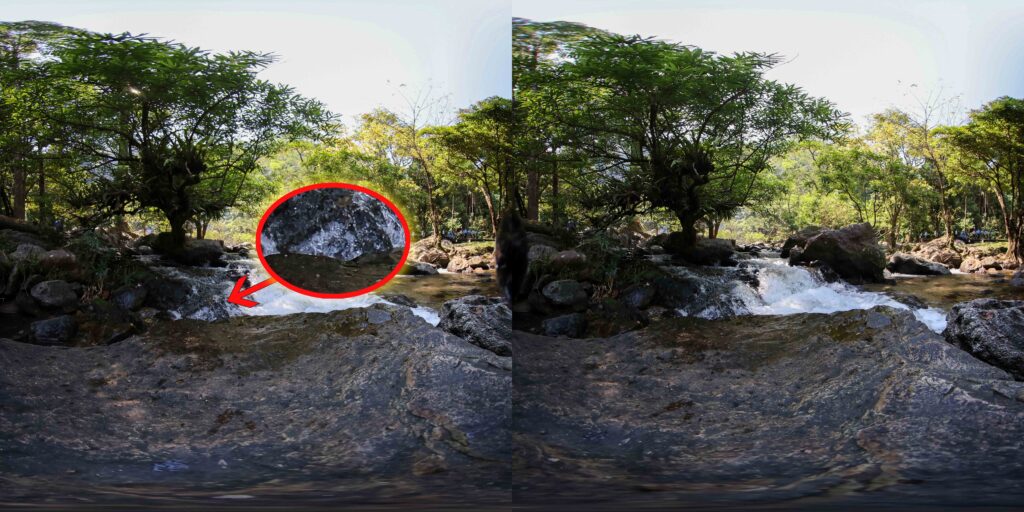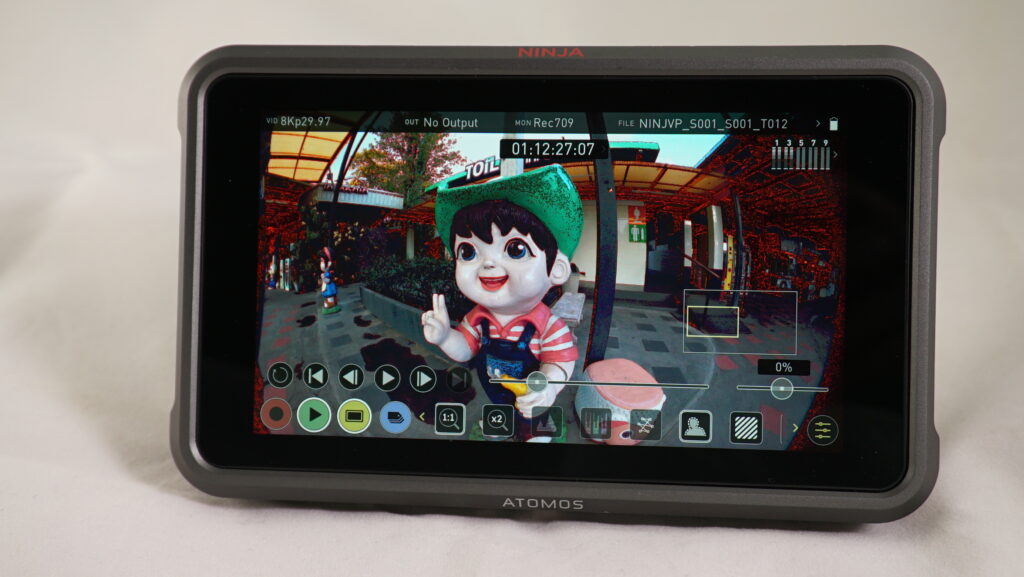My first 3D stereoscopic attempt was still images created with two cameras. Emboldened by that success, my first 3D stereoscopic video was a pair of cameras without sync that gave you an instant headache. Yes, we all must learn and evolve.
Getting Started

Note to all those out there, despite what others may say, you can not do professional 3D without fully synced cameras. Anyone trying to tell you otherwise is akin to selling snake oil to cure all your ailments. I’ve come a long way in the 30 years that have passed. Along the way, I’ve consulted with many hardware and software companies searching for the 3D Holy Grail.

I will tell you that Canon coming on board with the Canon R5 and then the Canon R5C with the RF 5.2mm Dual Fisheye Lens is the most complete system to date. And it’s something that 3D lovers are rejoicing over. We have never had a complete system for shooting 3D VR180 stills, and with the Canon EOS VR System, we can now shoot rapid 8K RAW images at a burst of 20 fps.
And with the R5C, we now have the ability to shoot super smooth 60fps 8K VR RAW video internally.


Let’s talk about the elephant in the room, so to speak, the heat issue with the R5. The Canon R5 is not an especially new camera, it was originally released in July 2020. The overheating issue has always been there, but when the RF 5.2 mm Dual Fisheye lens was released, the issue reached a boiling point for many of us hungry for the VR180 powerhouse. The issue isn’t as bad when you are shooting at a lower resolution, but I experienced it even while shooting those 20fps burst images. Likewise, the concern is less if you are recoding in HEVC format, but none of the homemade “fixes” have solved the problem. Tilta even came out with a heat sink/fan add-on that kind of sort of works but not really.

So along comes what may be the perfect storm, the R5C. It offers us compatibility with the RF 5.2 mm Dual Fisheye lens and fixes the overheat conundrum and gives us that fabulous 60fps video. Why you ask, is 60fps better? At recording speeds lower than 60fps, some videos, especially those with motion, could make some VR watchers ill. 60fps solves that, although as we progress, 90fps would be even better. But for now, VR headsets are not geared for 90fps video. I am not talking about VR games which are already at 90fps.
We still get that amazing 20fps still image burst and the ability to adjust the shutter speed. Nothing illustrates that better than these images of beautifully flowing water at the Klong Lan National Park in Thailand.

This image shot at ISO 1600 f/32 1/5000sec is a textbook illustration of “freezing” the water. You easily see the droplets as they splash against the rocks.

Contrast that with this image, shot at ISO 100 f/4 and 1/200 sec, slows the water down and creates more of a flowing effect.

Now let’s really slow it down with this image takes the settings to ISO 100 f/8 and 1/50 sec. Now you really see the blurred movement of the water as it runs its path.

Until now, VR180 disciples didn’t have these options, and I, for one, am thrilled. It opens up the artist’s palette to a whole new spectrum. In the past, if I wanted a still, I would have to pull a screenshot from the video timeline. Mostly it worked, but it did not afford me the opportunity to create a truly special shot by being able to adjust and get the look I wanted from the still.
The One Alternative the Atomos Ninja V+

If you really love the R5 but also love shooting 8K RAW, then the Atomos Ninja V+ offers the one sure alternative. By connecting to the HDMI out from the R5, you can record 8K ProRes RAW all day long, or at least until you have to change out hard drives. It works flawlessly and gives you many other advantages. Even if RAW isn’t your preferred format, the ability to record HEVC 4:2:2 10-Bit to your Atomos Ninja V+ is a fantastic advantage.
Canon EOS R5 or R5C
So now let’s look at each camera for what they have in common and what is very different.
To begin with, the R5C is NOT just an R5 with a fan.
Yes, the R5C has a cooling fan which is common on most of the Cinema grade EOS cameras. It has the option of always being on or auto. In auto mode, the fan turns on and off as needed for keeping the camera cool.
On the downside, the R5C does not have in-body stabilization. But if you are a VR shooter, that makes no difference since the R5 did not employ in-body stabilization with the RF 5.2mm Dual Fisheye Lens that you use for VR 180 shooting.

The weight (with battery and CFe Type B card) for the R5C is 770g (1.7 lbs) and the dimensions are 142 x 101 x 111 mm (5.6 x 4.0 x 4.4″)
The weight (with battery and CFe Type B card) for the R5 is 738g (1.63 lbs) and the dimensions are
139 x 98 x 88 mm (5.5 x 3.8 x 3.5″)

As you can see, the R5C is a little heavier and a little bigger than the R5. But one thing that is not so plain to see is that the R5C needs additional power in order to shoot the optimal 8K 60fps setting. So that means either using an external battery or the Canon Battery grip. But with that said, the R5 is also a power-mad beast, and I always use my Zendure Super Tak Pro with it connected to the USB-C port. So in that regard is a draw.
Both the R5 and the R5C feature a 45MP Dual Pixel AF CMOS sensor, which delivers 15EV of dynamic range. They also have a 5.76M dot electronic viewfinders and fully articulating 2.1M-dot rear touchscreens.

The hand-grips are identical, as are the woefully underpowered Canon batteries. Both have the same function buttons positioned in the exact locations. Still, on the EOS R5C, each button has indicators in grey to denote the default behavior in stills mode and a white label alongside the video button.
The R5 and R5C cameras have a single CFexpress slot and a UHS-II SD card slot. And while both cameras have both headphone and mic sockets, they also have Type D ‘Micro’ HDMI ports, despite the R5C’s more explicit focus on video work. I have to add that I don’t understand or agree with the choice of not using a full-size HDMI slot.

The EOS R5C also has the R5’s eye/head/person detection autofocus, even in video mode, along with the motorsports recognition AF mode introduced in the EOS R3. Again, if you are shooting VR, it does not apply.
One point that the jury, my jury anyway, is still out on is the two completely different operating systems for photo and video. Maybe because I got used to the ease of jumping from awesome VR stills to awesome VR video with just a few clicks, I feel like with the R5C, I won’t be shooting as many VR stills because of the time it takes to switch between the modes with a brief stop-over at the off position. The cycle between them seems much longer when you are trying to get the shot and move on.
In ‘Photo’ mode, the R5C is identical to the R5, with all the same menus and on-screen displays. But when you have to first turn off the ‘Photo’ and then turn on the ‘Video,’ you get an almost completely different camera more akin to the EOS Cinema Cameras. This probably makes sense in many ways, but I find it a bit disorienting.
Now for the BIG difference between the R5 and R5C, the video modes that are available.
The R5 was quite impressive with 8K 2 30fps and a choice of 8-bit H.264, 10-bit H.265, or 12-bit Canon RAW.

But the R5C really steps up its game with the ability to shoot 5.9K RAW extracted from a Super 35 crop or 2.9k capture extracted from a Super 16 part of the sensor.
If you don’t want to shoot RAW video, the EOS R5C, you have a choice of XF-AVC footage (a pro-grade 422 10-bit format w/ MXF-wrapped H.264 AVC file with metadata) at up to 4K/120 in a choice of Long GOP or ALL-I modes. The alternative is MP4 files, primarily using H.265 Long GOP compression, these allow for up to 8K/30 capture.
As the EOS R5C is a true Canon Cinema Camera, you also get waveform displays. With the R5, you would need to use the Atomos Ninja V+ in order to get this pro video feature.
With the R5C, you can capture HDR footage in the Hybrid Log-Gamma (HLG) broadcast standard. Both the R5 and the R5C allow for capturing PQ HDR footage as well.
The biggest negative to both cameras is the power system. The underpowered capacity of the LP-E6NH batteries used by the conventional EOS R5 means that, as I stated before, you either need the optional Canon Battery Grip or external power like the Zendure Super Tank Pro.
When it comes to the recording media, both cameras have both CFe and SD card slots. They are both equally particular as to the specifications for the types of cards used. This is another place where the Atomos Ninja V+ gives you many more options for recording and playback versatility.
In conclusion, which camera is best depends upon what you are shooting. I have strong opinions about both cameras, and if I had my way, I’d have an R5 for shooting VR180 still images. There has never been a camera in the market that even comes anywhere close, as I have shown in the examples.
But when it comes to VR180 video, the vote has to go to the R5C for many reasons, not the least of which is the ability to shoot 8K Canon RAW internally. That said, I would also still use the Atomos Ninja V+ as my trusted companion. But there would be times when I want to be more unencumbered. When using my Ronin S with the Canon R5C, the additional weight and flexibility might make it easier than using the Atomos.
So there you have it. Review it all and if you have a chance, try them both out and make your own choice but know that either way, the world of VR video filming has been changed forever by these two cameras.
Available soon on DEOVR Oculus/Meta Headset and YouTube

How are you watching your 360 VR Video?
Are you watching on your PC?
Is it Facebook? YouTube? Oculus TV?


Or are you using another smartphone with a Google Cardboard? Google Daydream?
Leave a comment below. Let us know what you like or don’t like. If you have seen a 360 VR video that you think is awesome, tell us, and we will feature it.
What type of VR Headset do you own? Or do you watch with your computer? Smartphone?

Do you have a VR camera?
Which VR Camera do you have?
And if you are looking for 360 Video Production Services, contact Al Caudullo exploretv@gmail.com
With 37 years of Media experience, we can Deliver More for You in 360 Video. Click here to see what our customers say about our work
Utilizing state of the art technology, Al Caudullo, and his team has been delivering award-winning compelling productions spanning the globe. Exotic destinations blended with unique cultural experiences give viewers an experience like no other.
From vibrant American cities like San Francisco and Las Vegas to the isolated mountains of Mongolia. From ancient civilizations of Cambodia and Myanmar to the lush resorts of Southeast Asia and beyond. All from the comfort of your living room.



